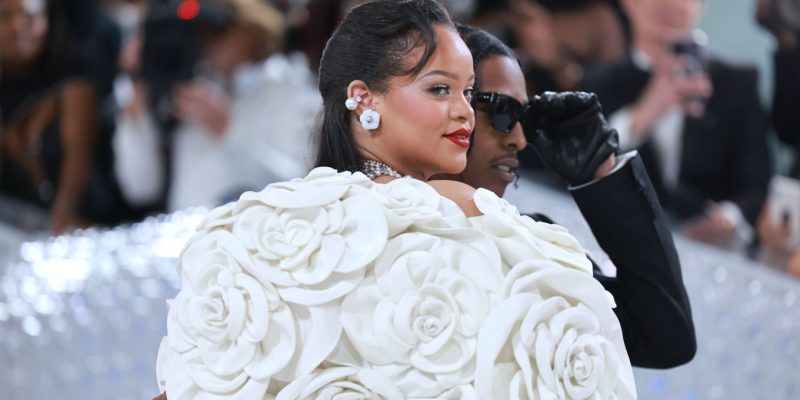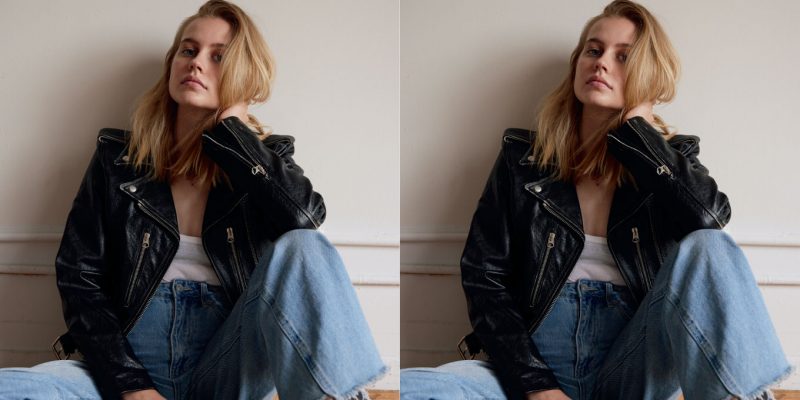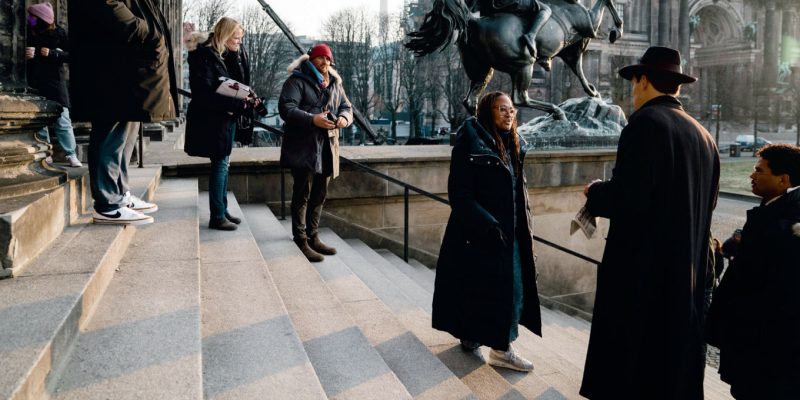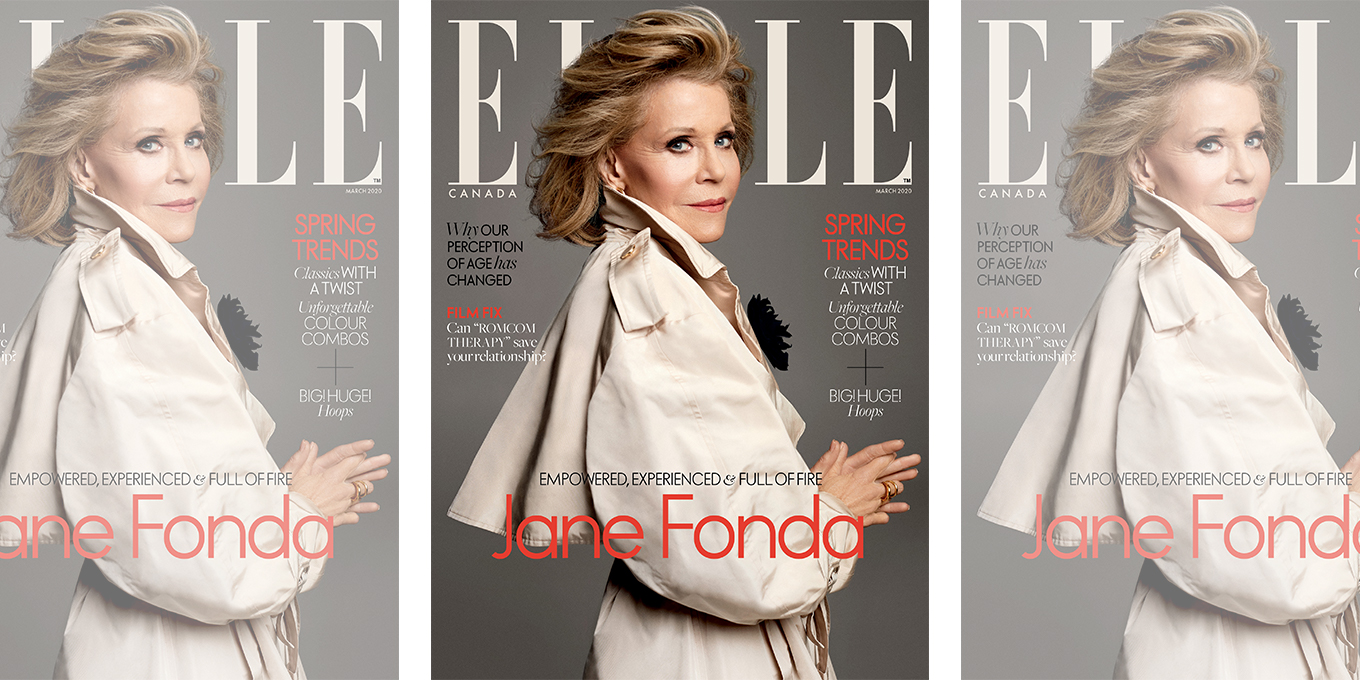
Max Abadian
Jane Fonda on Aging, Climate Change and Finally Living Life For Herself
by : Leanne Delap- Feb 11th, 2020
Even while getting arrested, Jane Fonda looks sensational. Lately, she has been working an assortment of chic berets and excellent coats—in particular a bold-red trench to better focus the camera’s eye, since she knows images will travel further and faster than her voice can. The social-media-savvy 82-year-old has been putting herself on the line for climate change in Washington, D.C., since the fall with her Fire Drill Fridays along with famous pals like Sam Waterston and Ted Danson. Every week, she has been led away in (ironically, single-use) plastic zip cuffs.
It’s a good thing, then, that Fonda is double-jointed. She confides this little nugget over mescal in Toronto in early September. It’s the secret to how she wrested her hands free from cuffs in order to give the raised-fist solidarity salute in her mug shot after her first arrest, in 1970 in Cleveland. Purportedly at the behest of Richard Nixon himself, Fonda was detained as she returned from a speaking tour in Canada for carrying vitamins—assumed to be drugs—in a plastic bag. She was exonerated, but those first arrest pics—featuring the choppy mullet from Klute, the film for which Fonda won her first Oscar—live on as legend.
The other (then) secret she shares is that she negotiated a four-month leave from her hit Netflix series, Grace and Frankie, in order to carry out her front-line work in Washington. Inspired by Greta Thunberg and Canadian author and social activist Naomi Klein—her “guru”—Fonda feels compelled, she explains, to “disrupt [her] comfortable life.” As she sees it, Klein’s new book, On Fire: The Burning Case for a Green New Deal, is the manifesto, the road map forward.
“They chose me not in spite of my age but because of my age.”
Fonda is in Toronto doing appearances as a proud spokesperson for L’Oréal Paris Age Perfect. “They chose me not in spite of my age but because of my age,” Fonda writes on her personal site. “They are committed to the idea that beauty is not simply in the young and model-perfect but in all people regardless of ethnicity or age.”
When we sit down to chat for this interview, it is approaching 7 p.m.; Fonda is finally ensconced in a private dining room at the Shangri-La Hotel after shaking hands and giving speeches and interviews for almost 12 hours straight. Her remarkable posture hasn’t flagged. In this era, when slouchy is the default, Fonda’s bearing alone marks her as special, regal even. The effect is amplified by her capacity to speak in complete, beautifully constructed and carefully-thought-out sentences, her intelligence crackling as loudly as her charisma.
Fonda has been…well, the only word is “relevant” for six decades. The daughter of acting legend Henry Fonda, she entered the public consciousness as a model in 1959, appearing on the cover of Vogue in an image shot by Irving Penn. After some New York stage work and training with the ultimate method-acting coach, Lee Strasberg, Fonda emerged as the sex kitten of ’60s French cinema. At the time, she was married to Roger Vadim, who directed her in 1968’s high-camp sci-fi classic Barbarella.
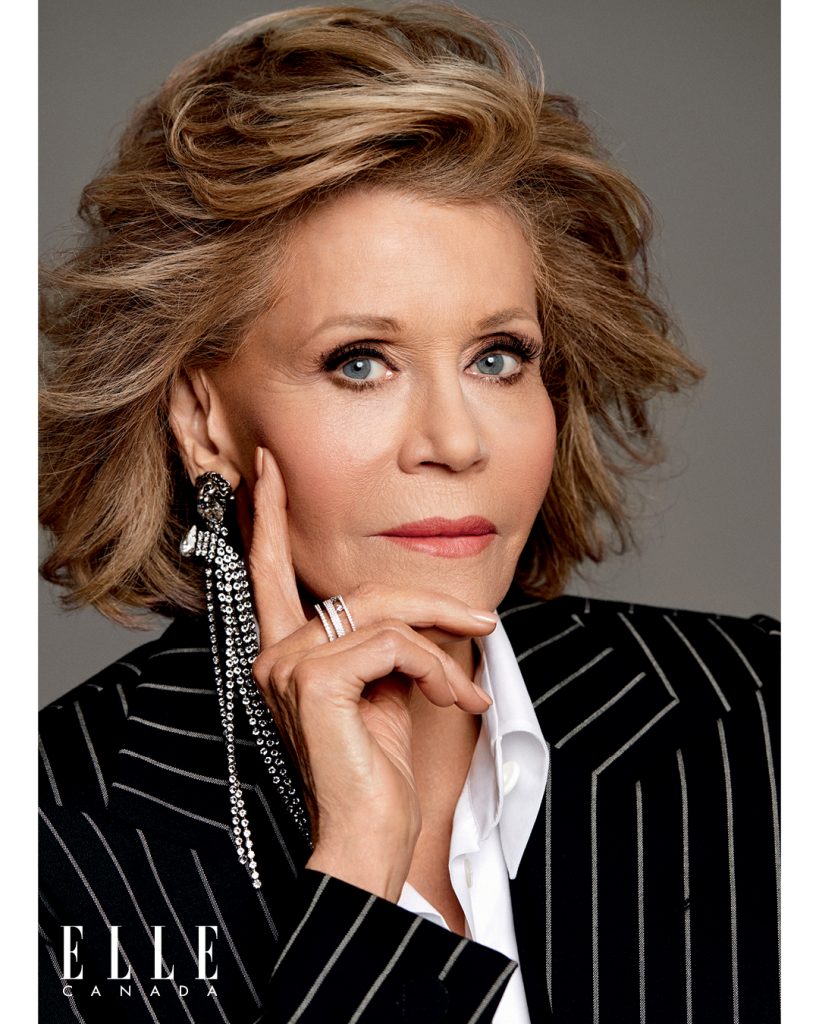 Max Abadian
Max Abadian Beauty note: Frame the face with L’Oréal Paris Age Perfect Eyebrow Defining Pencil.
While living in France, which at the time was consumed by student protests, Fonda took on the mantle of social-justice advocate, and that led to her next iteration as Vietnam activist—an identity that remains her most enduring and controversial. Meanwhile, she transformed her onscreen image by playing serious roles against type. (Her turn in 1978’s Coming Home, which won her a second Oscar out of a stunning seven lifetime nominations, stands out, as does 1979’s The China Syndrome.) By this time, she was married to California activist Tom Hayden and had evolved into a progressive Democrat.
Fonda has always been a step or two ahead of pop culture. For instance, she was the driver behind an early and powerful spotlight on the inequitable position of women in the workplace with 1980’s 9 to 5. Next, she turned her hand to entrepreneurship—but only for the cause: She came up with the era-defining Jane Fonda’s Workout series as a way to fund her social-justice projects with Hayden. As an unexpected bonus, she ended up turning the entire world on to leg warmers. Her subsequent identity was as Mrs. Ted Turner, a period during which Fonda temporarily retired from the film biz. Thus she spent the ’90s and early aughts cloaked in respectability, even as she quietly carried out groundwork for the Women’s Media Center and worked to prevent teen pregnancy in Georgia, where the power couple was based.
When she decided to leave Turner, whom she calls “her favourite ex-husband,” in 2001, she set off to find herself, embracing her own version of feminist, spiritual Christianity. It was a process that incited her to pen her memoirs—an exhaustive and therapeutic deep dive for the thorough personality—before making her triumphant return to acting, complete with claws, in the 2005 smash Monster-in-Law.
This quick breeze through her career highlights, incredible and varied as they are, unfairly glosses over the grit of the woman herself—the woman chomping at the bit to get back to the front lines of direct action. This Fonda, the real Fonda, is also at odds with the glossy images we’ve been treated to lately. She is killing it on the red carpet, her new stylist pulling age-defying couture pieces: a parade of chic jumpsuits, modern tuxedos and glam, of-the-moment gowns. Though the young women of Hollywood can’t touch her gravitas, Fonda’s success may be partly down to the fact that she doesn’t take it seriously. “Total facade,” she says, brushing off the acclaim. “I hate it because it is so uncomfortable.”
But if Jane Fonda is going to do something, she is damn well going to do it right. And she gets how the machine works: Having a hit TV show, she says, is what has given her renewed relevance with the public. Fame gives her a platform, even if it comes with a microscope. Fonda says calibrating the role of her physical appearance in her life has always been a battle.
She brings up the knife question herself. “I can’t pretend that I’m not vain, but there isn’t going to be any more plastic surgery—I’m not going to cut myself up anymore,” she says before taking a pained pause. “I have to work every day to be self-accepting; it doesn’t come easy to me.” Fonda is referencing the years she spent struggling with bulimia, an addiction she developed in childhood that she didn’t get under control until she was in her 40s. In fact, one of the ways she now uses social media—besides to drive coverage of her activism—is to model honesty. “I try to make it very clear that it has been a long and continuing struggle for me,” she explains. “I post pictures of me looking haggard—and once with my tooth out! This is a fake tooth,” she taps at an incisor. “It came out in a restaurant in Portugal, and I posted it.”
One of the other things Fonda has been struggling with for a long, long time is the role men have played in her story. Her Oscar-gilded, thrice-married life might not at first blush seem very “relatable.” But in the telling of her own truths—in her 2005 memoir, My Life So Far; her 2011 book on aging, Prime Time; and her 2018 HBO documentary, Jane Fonda in Five Acts—Fonda has always known she could connect with the rest of us. “I knew that if I really told the truth, it would be universal,” she says. “All these issues are universal among women: I’m not good enough; I have to please, starting with Daddy; I’m not pretty enough; I’m not thin enough; I’m not smart enough.”
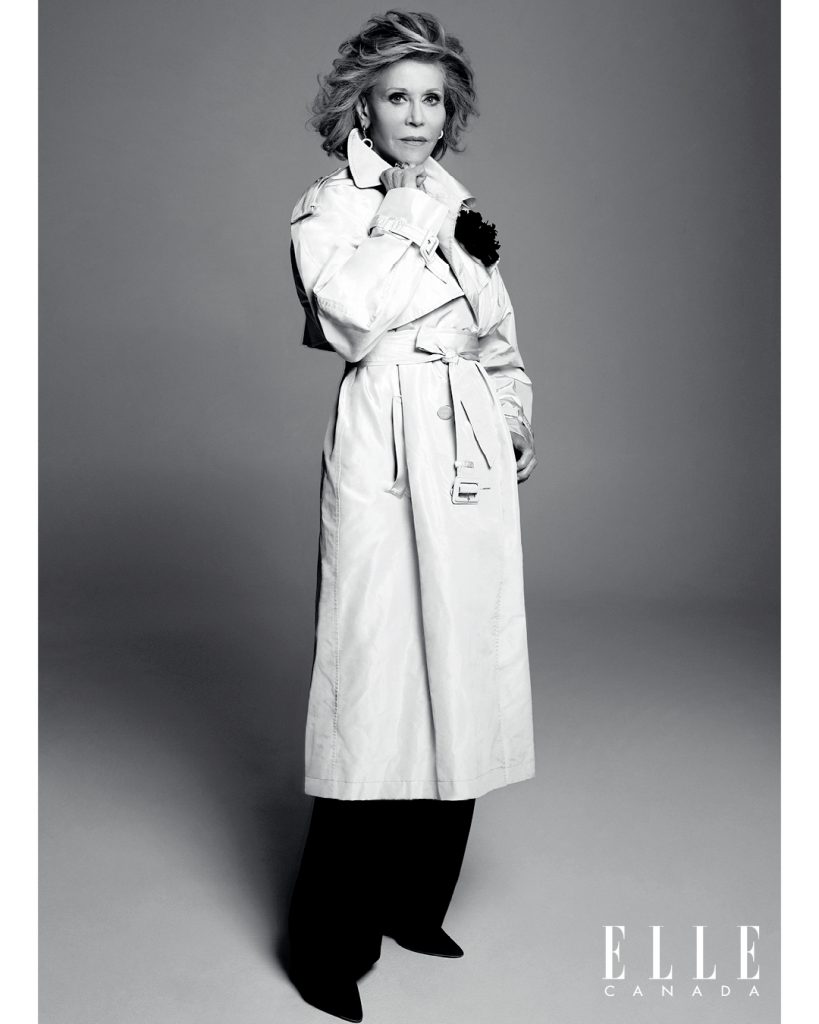 Max Abadian
Max Abadian Faille trench coat and Lemarié brooch (Alexandre Vauthier Haute Couture), gold-plated- metal and Swarovski-crystal ear- rings (Joanna Laura Constantine, at Archives), gold-vermeil ring (Charlotte Chesnais, at Archives) and top and pants (Fonda’s own).
She says that despite her own career success, she kept marrying men to give her an identity: new-wave cinema star with Vadim, social-justice warrior with Hayden, one half of a power couple with mogul Turner. Each time a relationship ended, she says, “I thought, ‘Well, that will be the end for me because no one’s going to want to be with me or talk to me if I’m not with him.’” The disease to please, she says, left her empty. Her singleness now is very much a conscious choice: She is dedicating this chapter of her life to herself. She repeats what has become her favourite interview zinger: “I’ve closed up shop down there.”
Her life onscreen now, in Grace and Frankie, reflects her real life in that it shows the importance of female friendships. Lily Tomlin, her co-star on the show, is one of her besties off-screen too. “The people who tend to really show up for me—and whom I show up for—are my women friends,” she says. “I grew up in the ’50s, and on top of that my mother killed herself, so I totally identified with men, which meant rugged individualism, so it was very hard for me to overcome that.”
“The people who tend to really show up for me—and whom I show up for—are my women friends.”
She drops in the reference to her mother’s suicide abruptly. It is hard to parse conversationally, but she has done a lot of explaining in her writing about how the profound loss, which occurred when she was just 12, shaped her, causing her to lean in to masculine role models. She came to terms with the tragedy many decades later, she says, by researching her mother’s life and mining her medical records. A grown-up Fonda came to internalize, finally, that her parents and grandparents were their own people with their own stories. And thus, she says, she was able to make the leap and accept that it wasn’t her fault.
Perhaps this painful journey explains why Fonda is so drawn to young people. She is both inspired by the young—the kids of Parkland, Thunberg—and worried about them. “Being young has always been harder,” she says. “There have been longitudinal studies—I wrote a book about aging, so I’ve studied this—that show how much easier, assuming [you have your] health, it gets when you are older. You know where the tiger is hiding. You’ve been through crises before and you’ve survived.”
Acting is a craft of empathy, and you can see Fonda trying to get inside what this generation is facing. “When you’re young, you are thinking: Who am I supposed to know? What am I supposed to do?” she says. And the climate crisis is always on her mind. “There is so much uncertainty now. It is 100 times worse than when I was a young person. And for me, those were not the good old days at all. It was very fraught,” she adds, raising her eyebrows to nod to that understatement. “And yet, I’m white and privileged, so for people of colour, gay people, physically challenged people, it is all so much harder.”
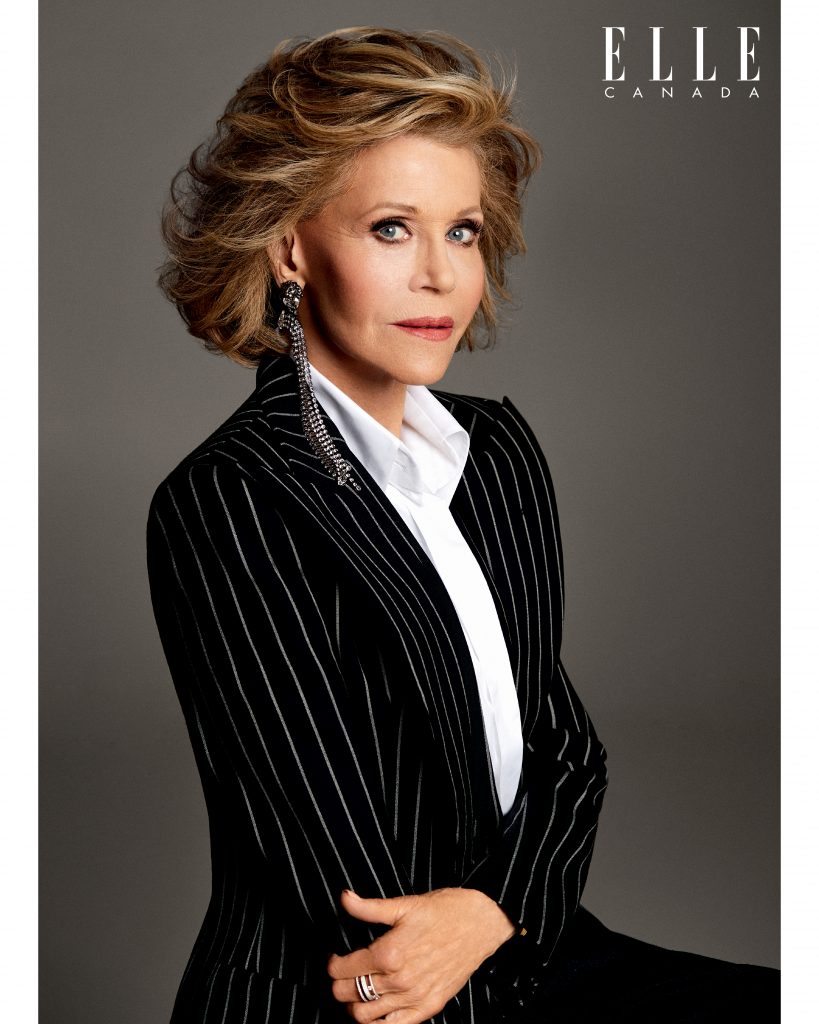 Max Abadian
Max Abadian Wool jacket (Alexandre Vauthier Haute Couture), woven shirt (Chanel), silver-tone and crystal earrings (Gucci, at SSENSE. com), white-gold and diamond ring (Messika) and pants (Fonda’s own). Get Jane’s look using L’Oréal Paris Age Perfect Radiant Concealer, Satin Blush, Satin Glide Eyeliner and Radiant Serum Foundation.
Acknowledging privilege is something Fonda does several times in every conversation. Her journey toward wisdom has involved a lot of therapy and her own version of a life review—you have to look back before you can look forward, she counsels. “Showing up is something you have to learn—although there are certain emotional disabilities you pick up when you are young that you can’t entirely undo,” she says. “I have psychic scars that I will never be able to give up. You learn to manage them. You learn to banish them to the corner and put a dunce cap on them and forbid them to come out.”
Because once you throw off the shackles of your past and jettison your guilt, you are freed up to do something good for the world. “I grew up at a time when the thinking was that women were like cats, competing with each other, knocking each other down,” says Fonda. “But, in fact, there is no limit to what we can accomplish if we work together,” she adds, eyes brightening again as she returns to her imperative. “What this time in human history calls for is collective action. And women are the most receptive to the idea of collective action. For evolutionary reasons, we are less susceptible to individualism. And in a way it’s our saving grace and it’s our strength. Nothing good ever happened without mass movement—and we need a mass movement now to focus on climate.”
“What this time in human history calls for is collective action.”
Collective action is in Fonda’s bones. It seems to frame her humility—this drive to be a part of something larger, a part of a solution. Hanoi Jane, the young woman who was universally reviled for sitting on an anti-aircraft gun in North Vietnam in 1972—an inadvertent action that she says is her biggest life regret—feels like another person from another lifetime. This Fonda is fully digested. But by owning the whole of her life, triumphs and missteps alike, Fonda is teaching all of us something: Wallowing is simply not an option. Marching together is the only way forward.
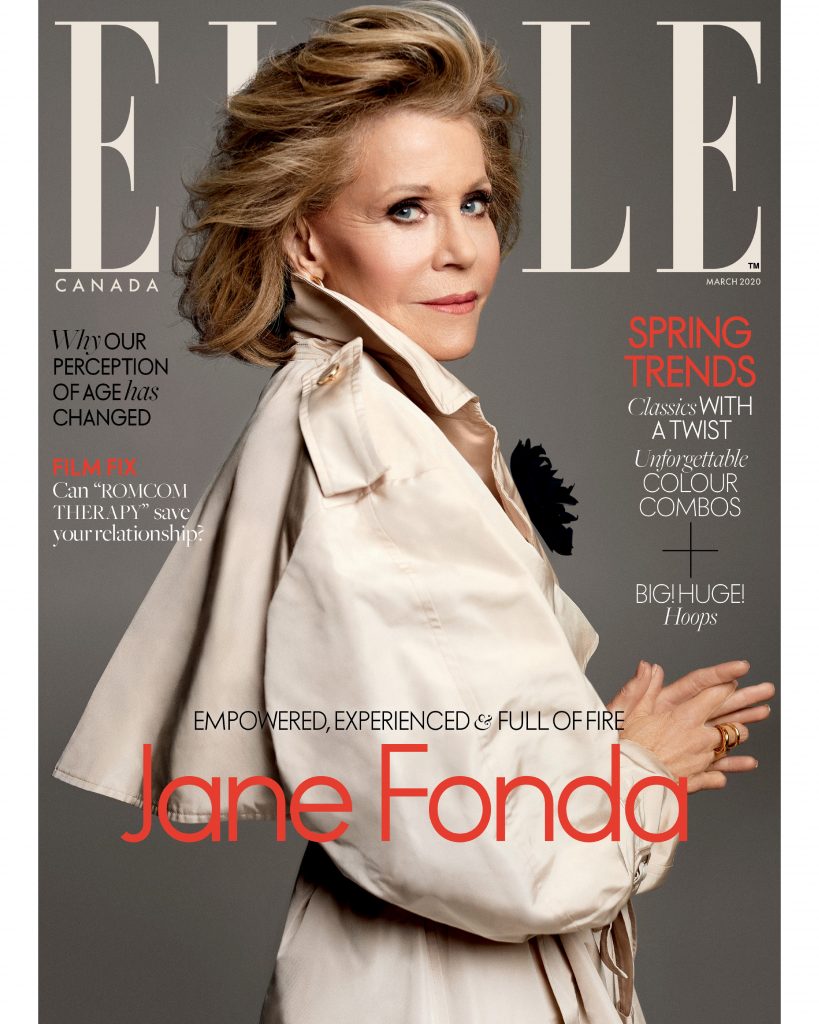
Photographer, Max Abadian; Stylist and creative director, Annie Horth; Art director, Jed Tallo; Makeup, David De Leon (ASM/L’Oréal Paris); hair, Jonathan Hanousek (Exclusive Artist Management/L’Oréal Paris); digital technician, Aljosa Alijagic; photographer’s assistant, Zach Hobler; styling assistants, Erica Ngao and Christina Tourloukis.
This article originally appeared in the March 2019 issue of ELLE Canada. Subscribe here.
Newsletter
Join our mailing list for the latest and biggest in fashion trends, beauty, culture and celebrity.
Read Next
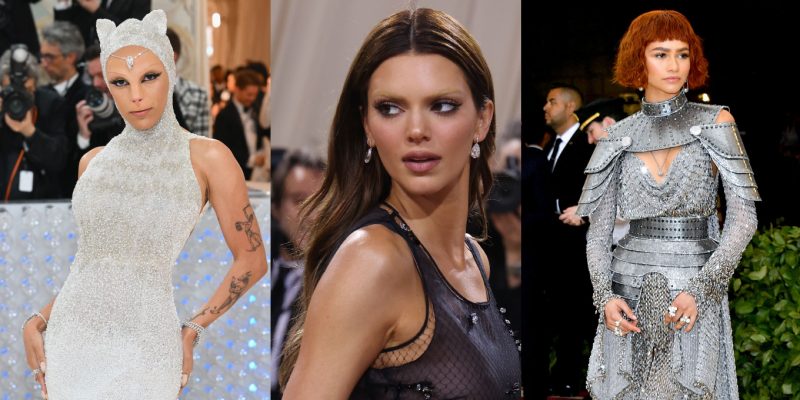
Beauty
The Best Met Gala Beauty Looks Of All Time
From Taylor Swift's 'Bleachella' era to Rihanna's iconic 2011 braids, meet the best beauty moments in Met Gala history.
by : Katie Withington- Apr 26th, 2024
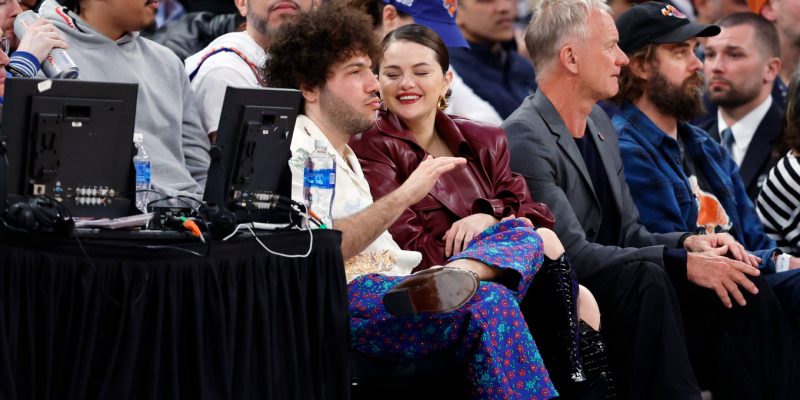
Culture
Benny Blanco Says He Fell in Love With Selena Gomez Without ‘Even Noticing’ It
Allow Benny Blanco to tell the straight-from-a-rom-com story of how he realized his feelings for his girlfriend and longtime friend.
by : Alyssa Bailey- Apr 26th, 2024
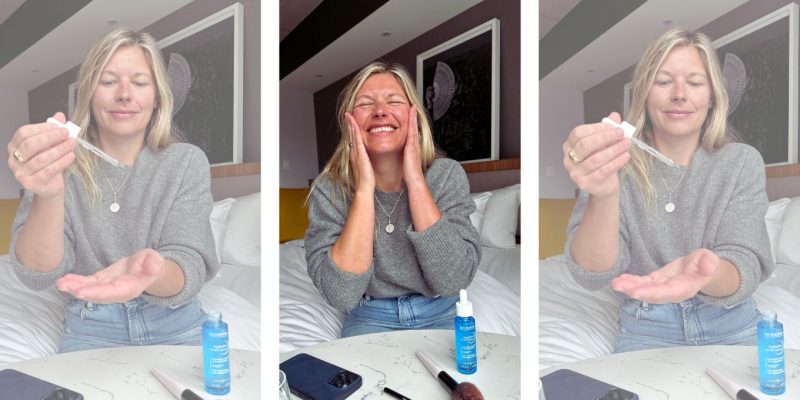
Beauty
Tested and Approved: Your New Hydrating Skincare BFF
This new product has all of your skin’s thirst-quenching needs covered.
by : ELLE Canada- Apr 17th, 2024

